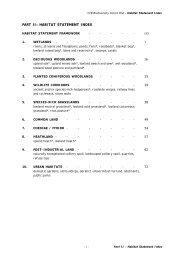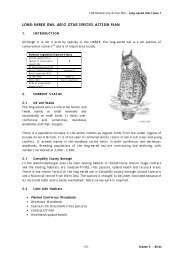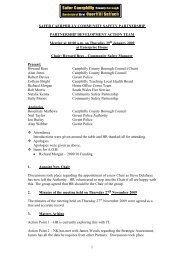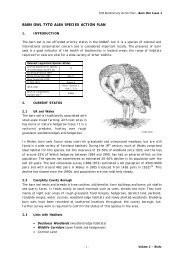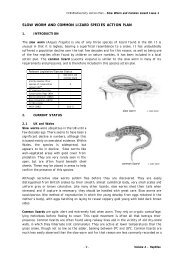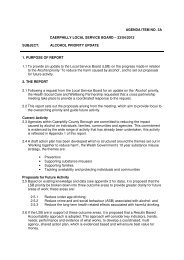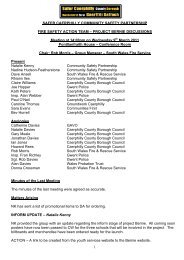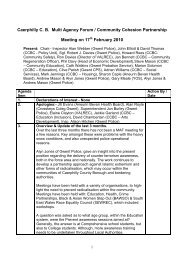DR LILY MOHAMED
DR LILY MOHAMED
DR LILY MOHAMED
- No tags were found...
You also want an ePaper? Increase the reach of your titles
YUMPU automatically turns print PDFs into web optimized ePapers that Google loves.
CONSUMPTION LEVELS MEN WOMEN
Canadian guidelines
Official UK NICE guidance is alcohol should beavoided during the first three months ofpregnancy. Beyond three months, a safelevel of alcohol has not been firmlyestablished, though the guidance statesthere is no evidence of harm from drinking amaximum of 1-2 units once or twice a week.
Alcohol is a Teratogen• A teratogen is a substance thatinterferes with the normal developmentof the fetus• Specifically, alcohol is aneurobehavioural teratogen – alcoholcan damage the brain and changebehaviour
Alcohol passes across the placenta frommother to child as early as 2 weeksafter conception until birth.Excessive alcohol intake can causedamage during all stages of prenataldevelopment• Pre-implantation: first 2 weeks• Embryonic: 3 - 8 weeks afterconception• Fetal: from 9 weeks until birth
Teratology:Four Outcomes to Exposure• Malformations (facial, heart, skeletal)• Growth Deficiency (small)• Functional Deficits (learning andbehavioural problems)• Death (stillbirth, miscarriage)
Effects of alcohol on pregnancy• Adverse effects to the fetus occur at levels at or belowthat are toxic to women• Fetal elimination of alcohol is poor• Harm can be cause before a woman knows she is pregnant
What is FAS and FASD?FASD – Fetal Alcohol Spectrum Disorders- Not a diagnostic but an umbrella termthat encompasses all disabilities causedby prenatal exposure to alcohol
FAS – Foetal Alcohol Syndrome- A group of symptoms seen in children who wereexposed to alcohol before birth and characterised by:Growth deficiency, Facial characteristics and CNSdamageARND – Alcohol Related NeurodevelopmentalDisorders- A diagnostic classification for individuals who wereprenatally exposed to alcohol and do not have the facialcharacteristics of full FAS but have symptoms of CNSdamage associated with FASARBD – Alcohol Related Birth Defects- A diagnostic classification for individuals who wereprenatally exposed to alcohol and have physical defectssuch as malformation of the heart, bone, kidney, visionor hearing systems
Facial characteristics of FAS
A. MRI showing the side view of a 14 yr old control subject with anormal corpus callosumB. 12 yr old with FAS and a thin corpus callosumC. 14 yr old with FAS and agenesis of the corpus callosumSource: Mattson, SN; Jernigan, TL; and Riley, EP 1994
DiagnosisNot easy because:1. FAS can be difficult to diagnose at andafter birth2. FAS can easily be confounded with manyother disorders3. There is no one clinical feature thatspecifically identifies FAS4. There is no laboratory test to aid in thediagnosis
TreatmentNo cure for FASDTreatment services will be different for eachperson depending on symptomsRequires a multidisciplinary approachSome factors that help improve outcomeinclude:• Early diagnosis – before 6 years of age• Special education and social services• A loving, nurturing and stable householdenvironment• Absence of violence
PrognosisDepends on the type and severity of the child age atwhich treatment beginsOne study followed a group of FAS individuals aged 12to 51 years. Researchers reported the following longterm consequences:95% had mental health problems55% had spent time in prison, a drug and alcoholtreatment centre or a psychiatric hospital60% had been in trouble with the law82% were unable to live independently70% had problems holding a job60% had problems with drugs or alcohol[Streissguth and O Malley (2000)]
Cost ImplicationThe life time cost for one individual with FAS in 2002was estimated to be $2 million. It is estimated thatthe cost to the United States for FAS alone is over $4billion annually.Alaska
SERVICES IMPACTED BY FASD
Incidence• No reliable evidence onincidence of FASD in the UK• In England and Scotland,data are only collected onFAS and not FASD• Estimate in 2004 0.21 per1000 live births• No data available forNorthern Ireland and WalesEpidemiologyPrevalenceInternational prevalence• 1/1000 FAS• 9.1/1000 FASD (O’Leary2003)• 1-2/100 FASD (University ofWashington 2004)This figure is changingFigure as high as 3.5% hasbeen quoted in someresearch (May 2006)We don’t know what is the UKfigureData from clinical coding dept at RGH showed thatthere are 3 patients with FAS diagnosis in Gwent in thelast 5 years and each had multiple admissions.
Percentage of females who reported drinkingabove guidelines by nation, 2006Source: General Household Survey 2006WALES
Drinking in PerspectiveIn general women:• may drink alcohol before they realize theyare pregnant• may not know alcohol is harmful to thedeveloping fetus• may drink because it is the social/culturalnorm• may drink to self-medicate
What’s happening in Gwent?• Task and finish group- Assisting in Alcohol Brief Interventiontraining for midwives- Seeking funding for alcohol awarenesspromotional literature- Pre-festive season campaign
Key Messages• Drinking alcohol during pregnancy cancause birth defects• There are no known safe limits• It is best to plan ahead and to stop drinkingbefore getting pregnant• It is never too late to stop drinking
THANK YOU!ANY QUESTIONS?



